Local authorities, together with other local governance actors have an important role to play in developing effective disaster risk strategies and initiatives for climate action and sustainable development.
As they form the closest institutional level to citizens and communities, local authorities bear the responsibility to build resilient communities. The Sendai Framework explicitly calls for the full empowerment of local authorities, through regulatory and financial means to work and coordinate with relevant stakeholders in disaster risk management at the local level. UNDRR empowers local authorities to reduce existing risks and strengthen resilience of communities by providing capacity-building, knowledge and normative support.
Making Cities Resilient 2030 (MCR2030) is a unique cross-stakeholder initiative for improving local resilience through advocacy, sharing knowledge and experiences, establishing mutually reinforcing city-to-city learning networks, injecting technical expertise, connecting multiple layers of government and building partnerships.
Launched on 28 October 2020, MCR2030 aims to leverage knowledge and expertise of partners to support cities through a clear three-stage resilience roadmap, from enhancing knowledge on risk and resilience, putting in place disaster risk reduction and resilience strategies, and moving toward implementation and taking actions to strengthen resilience.
Through delivering a clear roadmap to urban resilience and providing access to knowledge management and monitoring and reporting tools, MCR2030 will support cities on their journey to reduce risk and build resilience. MCR2030 aims to ensure cities become inclusive, safe, resilient and sustainable by 2030, contributing directly to the achievement of Sustainable Development Goal 11 (SDG11) and other global frameworks including the Sendai Framework for Disaster Risk Reduction, the Paris Agreement and the New Urban Agenda.
Toolkits
Quick Risk Estimation (QRE)
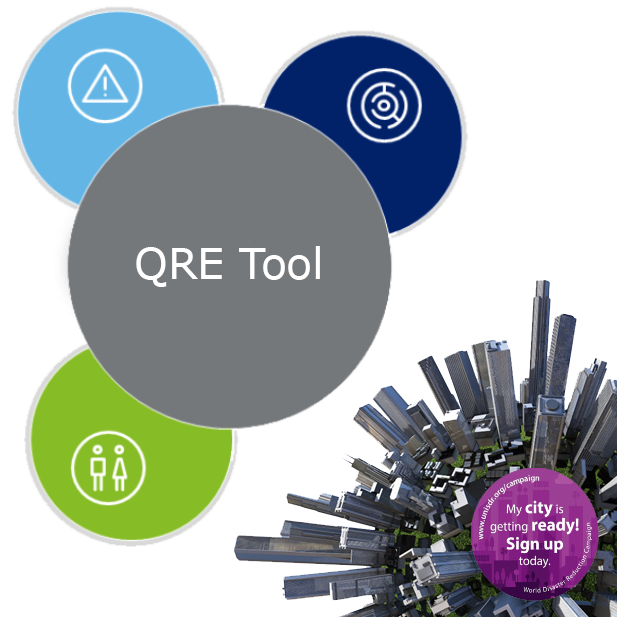
A tool to identifying and understanding current and future risks / stress / shocks and exposure threats to both human and physical assets.
The Quick Risk Estimation (QRE) tool has been designed for the purposes of identifying and understanding current and future risks / stress / shocks and exposure threats to both human and physical assets. The QRE Tool is not a full scale risk assessment, rather a multi-stakeholder engagement process to establish a common understanding. Taking into account the actions or corrective measures already undertaken, the QRE will produce a dashboard-style risk assessment advising the risks and hazards to human and physical assets, impacts of identified main risks and associated perils on the specified location and/or particular asset.
The QRE tool uses the hazards classification outlined by the United Nations Office for Disaster Risk Reduction (UNDRR). The hazard indicators included in the QRE tool are aligned to the 10 Essentials for Making Cities Resilient Scorecard in the context of the Sendai Framework for Disaster Risk Reduction 2015 - 2030 and the Sustainable Development Goals.
QRE is currently available in English, Mongolian, Portuguese, Russian, Spanish and Thai
Thematic Addenda:
Quick Risk Estimation Tool for Integrated Climate and Disaster Risks (Climate QRE)
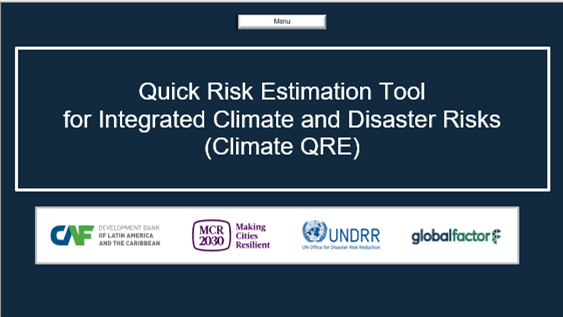
A 'rapid’ and ‘simplified’ climate and disaster risk analysis tool to support cities and municipalities in making informed decisions about risk with essential information for immediate action. Highly useful in situations where there is limited time or resources available to perform a detailed assessment.
Disaster Resilience Scorecard for Cities

A tool for disaster resilience planning
United Nations Office for Disaster Risk Reduction with the support of European Commission, IBM, AECOM and other partners and cities participating in the Making Cities Resilient Campaign have updated the Disaster Resilience Scorecard for Cities.
The Scorecard provides a set of assessments that allow local governments to assess their disaster resilience, structuring around UNDRR’s Ten Essentials for Making Cities Resilient. It also helps to monitor and review progress and challenges in the implementation of the Sendai Framework for Disaster Risk Reduction: 2015-2030 and supports the baseline analysis for preparation of the disaster risk reduction and resilience strategies.
It offers the potential for scoring at two levels:
- Level 1: Preliminary level, responding to key Sendai Framework targets and indicators, and with some critical sub-questions. This approach is suggested for use in a 1 to 2 day city multi-stakeholder workshop. In total there are 47 questions indicators, each with a 0 – 3 score;
- Level 2: Detailed assessment. This approach is a multi-stakeholder exercise that may take 1 –4 months and can be a basis for a detailed city resilience action plan. The detailed assessment includes 117 indicator criteria, each with a score of 0 – 5.
Disaster Resilience Scorecard for Cities is currently available in more than 15 languages.
Thematic Scorecard Addenda and Annexes:
Public Health System Resilience Scorecard
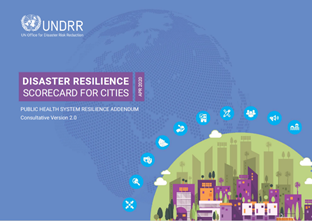
Public health scorecard addendum strengthens and integrates coverage of the many aspects of public health that are relevant to disaster planning, mitigation and response, helping to ensure of the integration of public health issues in disaster risk management.
Public Health System Resilience Scorecard is currently available in more than 15 languages.
Food System Resilience addendum
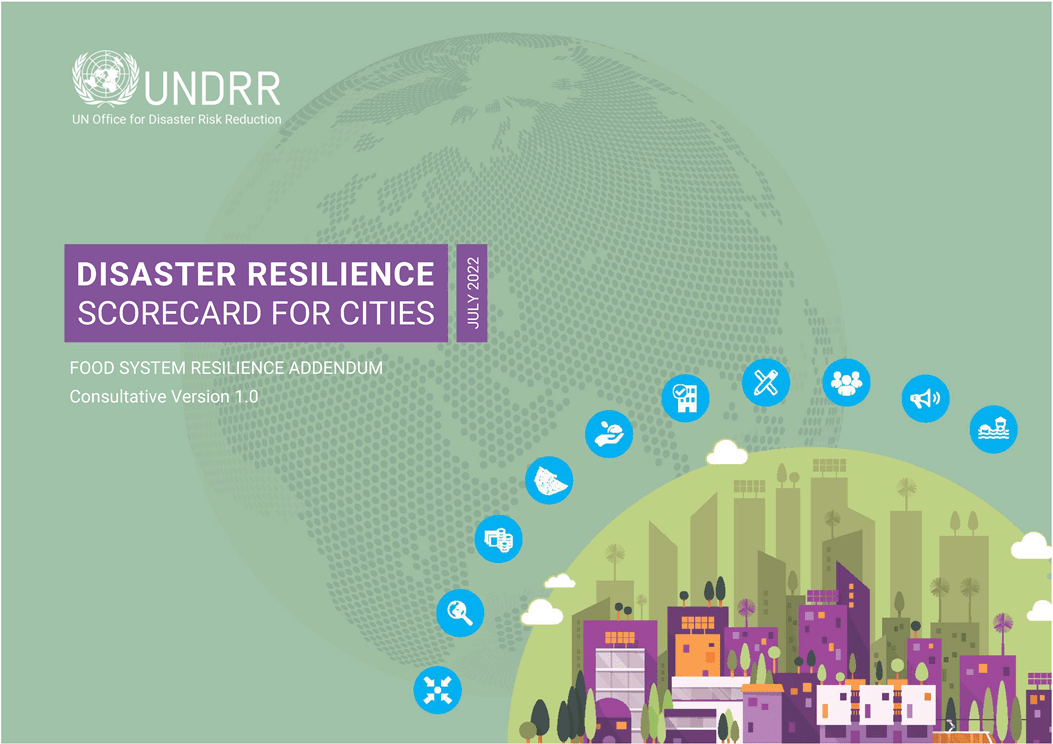
Food System Resilience addendum is structured in sections around the same “Ten Essentials for Making Cities Resilient” as the Scorecard. The Ten Essentials provide a holistic coverage of the many issues that affect resilience in the “system-of-systems”, which make up a system. This includes food production, supplies, transport and services.
Cultural Heritage Addendum
Cultural Heritage Addendum to the Disaster Resilience Scorecard for Cities aims to support the development of culture-based and people-centered disaster risk reduction and resilience strategies integrated with cultural heritage and development policies.
Annex for the Inclusion of Persons with Disabilities
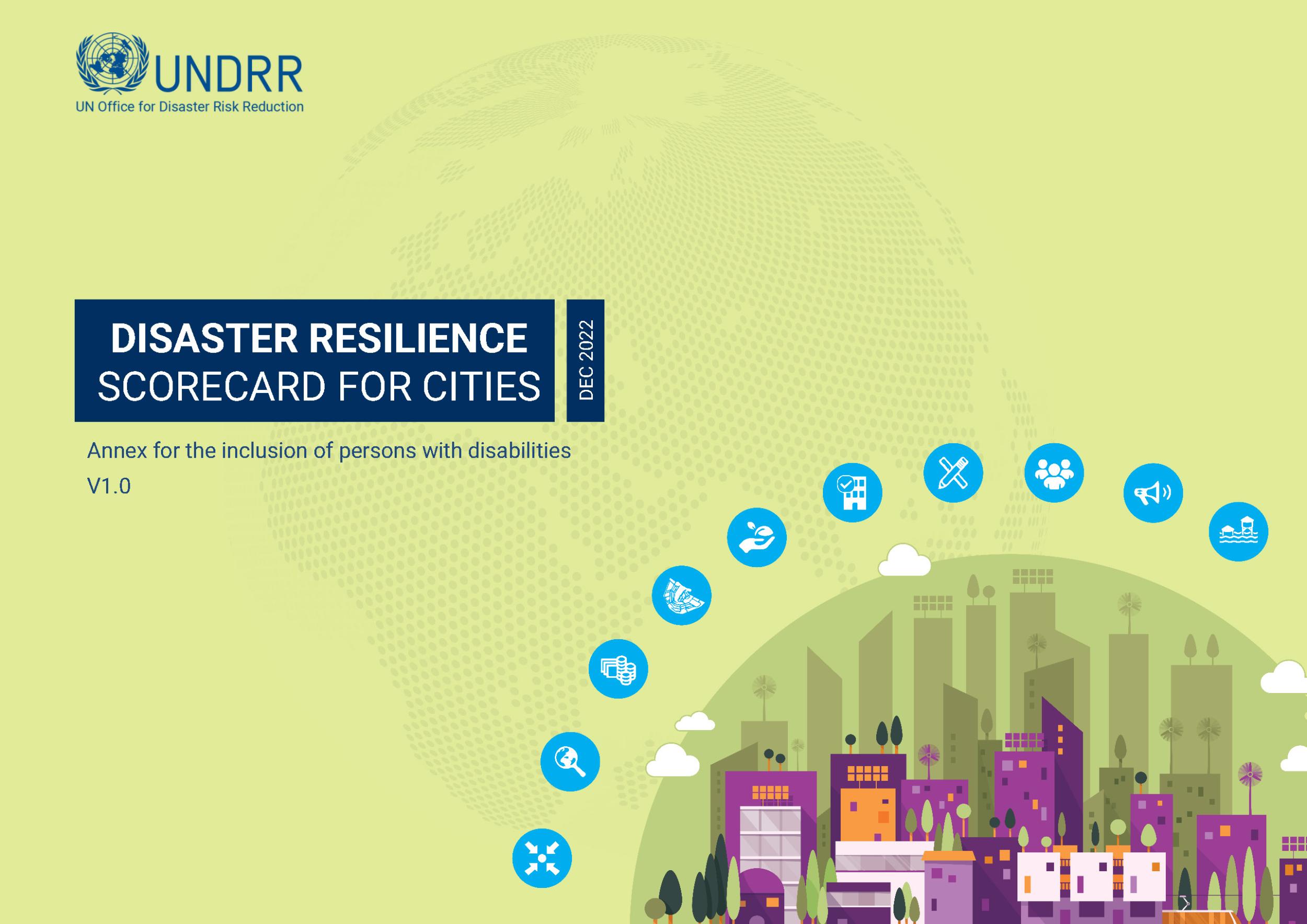
Annex for the Inclusion of Persons with Disabilities includes specific criteria on considerations for the inclusion of persons with disabilities for each of the Ten Essentials for Making Cities Resilient. It seeks to support the formulation of local strategies and plans for enhancing more resilient and inclusive cities, together with two crosscutting principles, close consultation with and active involvement of persons with disabilities through their representative organizations and accessibility. It aims to promote inclusion and accessibility in the urban environment, so that no person with a disability be left behind.
Climate Resilience Addendum

The Climate Resilience Addendum allows users to self-assess the interlinkage and integration of disaster risk reduction and climate change adaptation at the sub-national government level strategies and practices. Originally developed in Spanish through a collaboration of the Development Bank of Latin America and the Caribbean (CAF) and UNDRR, this version integrates feedback from city pilots and consultative review.
Related

UNDRR Global Education and Training Institute (GETI) is the global coordinator of MCR2030.
